Creare una pagina di archivi personalizzata in WordPress può migliorare significativamente la navigazione del tuo sito e la reperibilità dei contenuti.
Noi di WPBeginner abbiamo implementato la nostra pagina di archivi personalizzata per aiutare i lettori ad accedere facilmente alla nostra vasta raccolta di post del blog e tutorial.
Una pagina di archivi ben progettata può migliorare l'esperienza utente, aumentare l'engagement e persino aiutare con la SEO fornendo una chiara struttura del sito. È utile per siti ricchi di contenuti, blog e riviste online in cui i visitatori potrebbero voler approfondire argomenti specifici.
In questo articolo, ti mostreremo come creare una pagina di archivi personalizzata in WordPress.
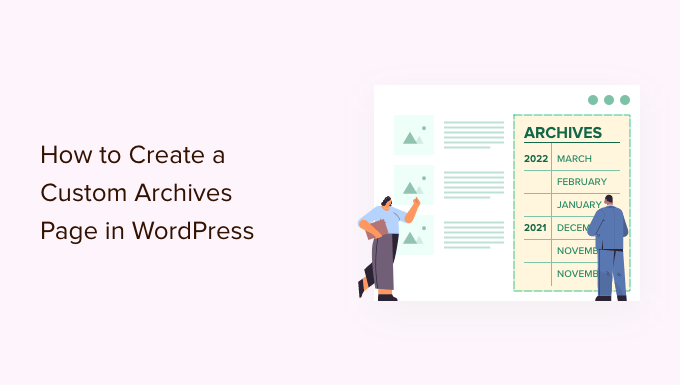
Perché creare una pagina di archivi personalizzata in WordPress?
Una pagina di archivi mira a visualizzare un elenco cronologico dei tuoi post passati, rendendo più facile per i visitatori esplorare i tuoi contenuti in base alle date di pubblicazione.
Se sei un blogger, avere una pagina di archivi è un must. Fornisce un modo conveniente per gli utenti di accedere ai post più vecchi senza dover scorrere l'intero blog.
Potresti voler creare una pagina di archivi personalizzata se il tuo tema attuale non dispone di un modello di pagina di archivi. Anche se lo fa, potresti comunque volerlo personalizzare in base alle tue esigenze.
Noi di WPBeginner utilizziamo una pagina di archivi personalizzata che presenta un pulsante che indirizza gli utenti alla nostra raccolta di guide WPBeginner. In questo modo, i nuovi lettori possono semplicemente cliccarci sopra per vedere le nostre risorse delle guide definitive.
Inoltre, organizziamo tutti i nostri post del blog per anni e mesi in modo che i lettori possano vedere facilmente quali articoli sono stati pubblicati in un determinato periodo.
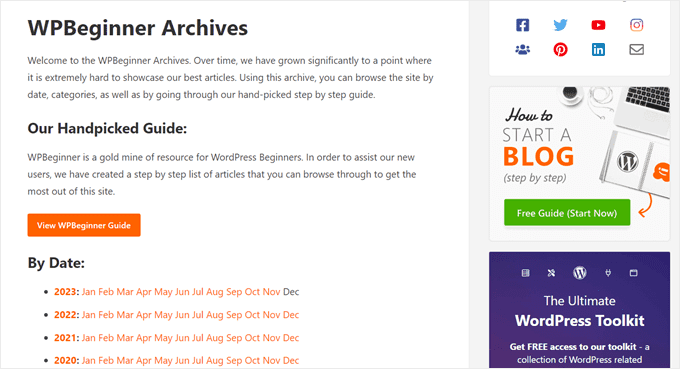
Qui, abbiamo anche aggiunto le categorie e i tag del nostro sito alla pagina di archivio personalizzata.
In questo modo, i visitatori possono trovare facilmente post più vecchi che potrebbero interessarli. Se fai questo per il tuo blog, avrai maggiori possibilità di aumentare le tue visualizzazioni di pagina e ridurre il tuo tasso di rimbalzo.

Tenendo conto di ciò, vediamo come puoi creare una pagina di archivi personalizzata in WordPress, indipendentemente dal tema che stai utilizzando.
Utilizza semplicemente i collegamenti rapidi qui sotto per passare direttamente al metodo che desideri utilizzare.
- Metodo 1: Crea un modello di archivio personalizzato utilizzando l'editor a blocchi (senza plugin)
- Method 2: Create a Custom WordPress Archive Page Using Seedprod (Recommended)
Metodo 1: Crea un modello di archivio personalizzato utilizzando l'editor a blocchi (senza plugin)
Se stai utilizzando un tema a blocchi, l'editor completo del sito rende facile progettare un modello di pagina di archivio personalizzato.
Questo metodo non funziona con tutti i temi, quindi se non stai utilizzando un tema WordPress basato su blocchi, ti consigliamo di utilizzare invece un page builder.
Per iniziare, semplicemente crea una nuova pagina o apri una pagina esistente che desideri utilizzare come archivio. Nel menu a destra, fai clic sulla scheda 'Pagina' e quindi seleziona il collegamento accanto a 'Modello'. Il testo esatto del modello può variare a seconda del modello che stai utilizzando attualmente.
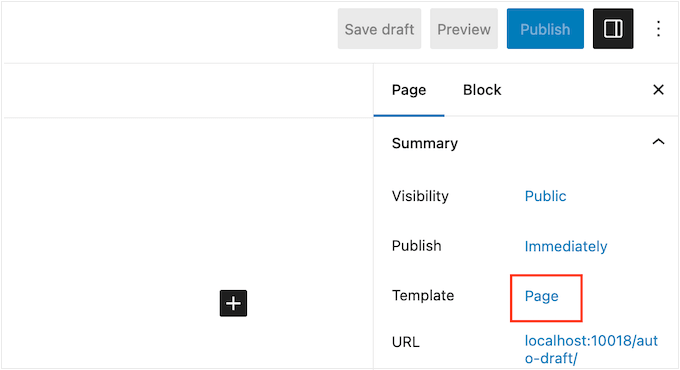
Ora apparirà un popup con il tuo modello attuale.
Vai avanti e fai clic sull'icona 'Nuovo modello'.
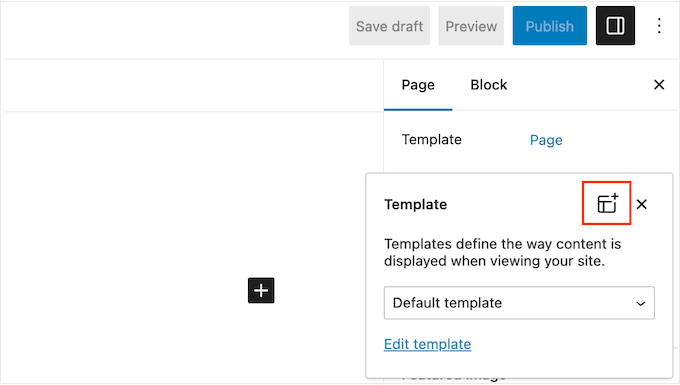
Nel popup, digita un nome per il modello di pagina personalizzato. Il nome del modello è solo per riferimento, quindi puoi usare quello che vuoi.
Quindi, procedi e fai clic su 'Crea' per avviare l'editor del modello.
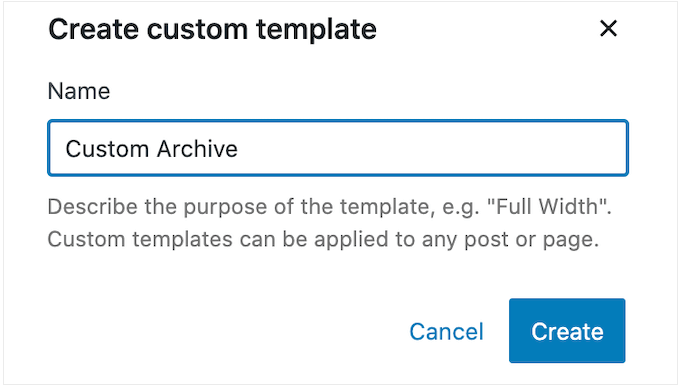
L'editor di template funziona in modo simile al normale editor a blocchi di WordPress.
Per aggiungere blocchi alla tua pagina archivi personalizzata, fai semplicemente clic sul pulsante blu ‘+’. Puoi quindi trascinare e rilasciare per aggiungere blocchi al tuo layout.
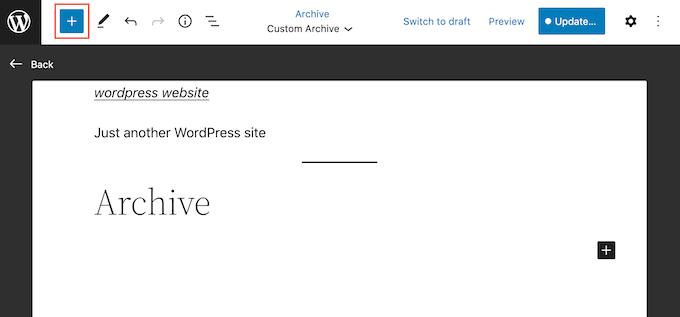
Poiché stiamo creando una pagina archivi personalizzata, in genere vorrai iniziare aggiungendo un blocco Archivi. Questo blocco di WordPress consente ai visitatori di esplorare i tuoi post in base all'anno, al mese, alla settimana o al giorno.
Ad esempio, l'immagine seguente mostra un blocco Archivi in cui i post sono organizzati in archivi mensili.
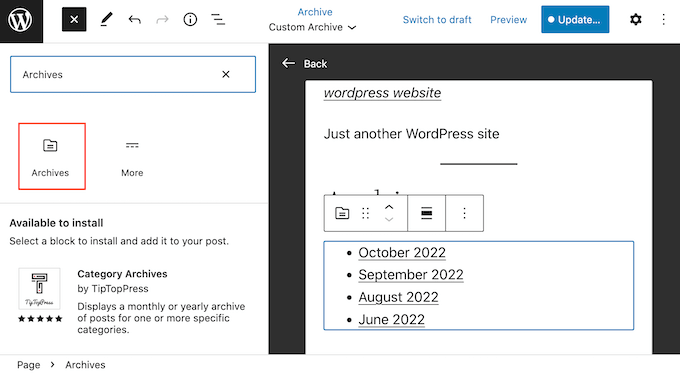
Facendo clic su uno qualsiasi di questi collegamenti, il visitatore verrà indirizzato a una nuova pagina che mostra tutti i post pubblicati durante quel periodo.
Per aggiungere un blocco Archivi, trovalo semplicemente nel menu a sinistra e quindi trascinalo sul tuo layout. Dopo aver aggiunto qualsiasi blocco, è una buona idea esaminare le sue impostazioni nel menu a destra.
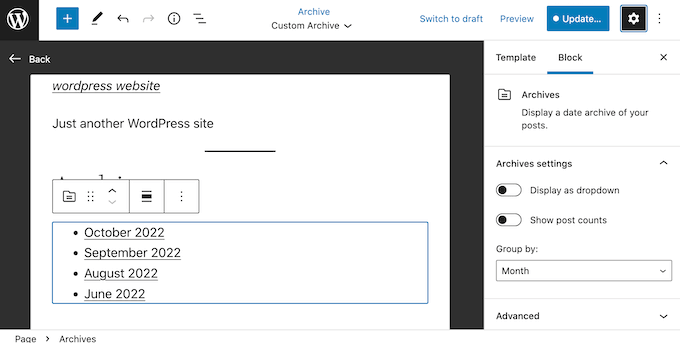
Per iniziare, potresti voler cambiare il modo in cui i post sono organizzati aprendo il menu a discesa ‘Raggruppa per’ e scegliendo un’opzione dall’elenco.
Ad esempio, se hai solo un piccolo numero di post, potrebbe avere senso mostrarli per giorno.
Tuttavia, se hai molti contenuti, di solito vorrai scegliere ‘Mese’ o addirittura ‘Anno’ in modo da non sopraffare i visitatori con un lungo elenco.
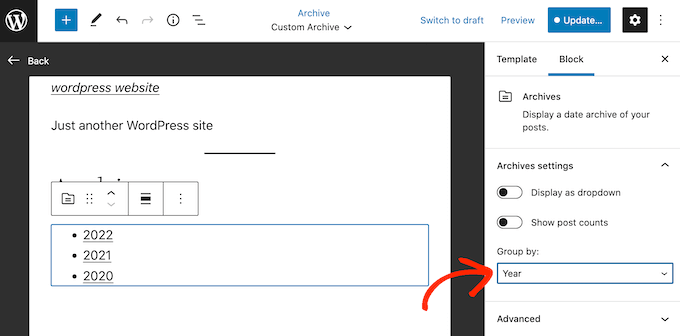
WordPress mostra i post archiviati in un elenco puntato per impostazione predefinita, ma puoi anche presentarli come un menu a discesa.
Questo può essere utile se hai pochissimo spazio e devi creare un archivio compatto. Per passare a un formato a discesa, fai semplicemente clic sul cursore ‘Mostra come menu a discesa’ per attivarlo.
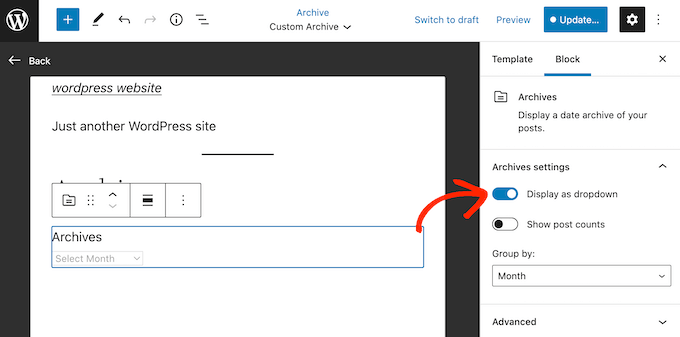
Il blocco Archivio può anche mostrare il numero totale di post accanto a ogni intestazione.
Questo può aiutare i visitatori a decidere quale parte dell’archivio vogliono esaminare per prima.
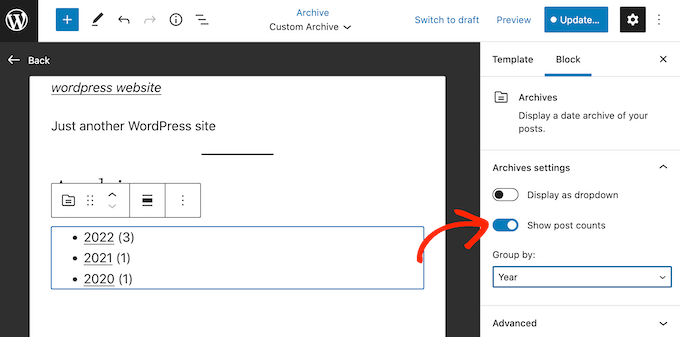
Potresti anche voler aggiungere un archivio per categoria in modo che i visitatori possano esplorare i tuoi post in base al loro contenuto e non solo alla data. Questo può aiutare i visitatori a trovare contenuti interessanti, il che li manterrà più a lungo sul tuo sito web e migliorerà il tuo SEO di WordPress.
Per aggiungere questo blocco, fai semplicemente clic sul pulsante blu ‘+’ e digita ‘Elenco categorie’. Quando appare il blocco giusto, aggiungilo al tuo layout trascinandolo.
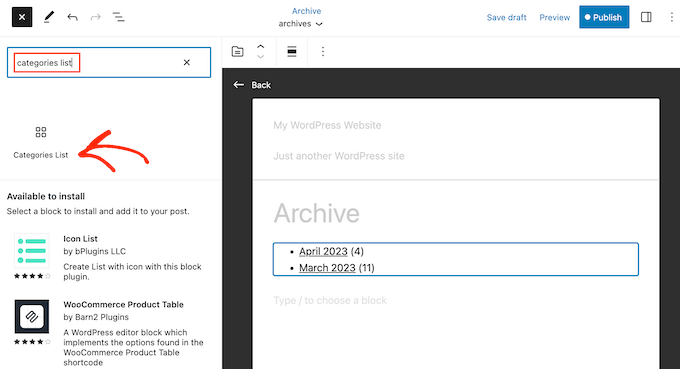
Ancora una volta, potresti voler apportare alcune modifiche alle impostazioni del blocco.
Simile al blocco Archivi, puoi aggiungere un conteggio dei post all’elenco o mostrare le categorie come menu a discesa anziché come elenco puntato.
Per impostazione predefinita, questo blocco mostra tutte le categorie e sottocategorie esattamente nello stesso modo.
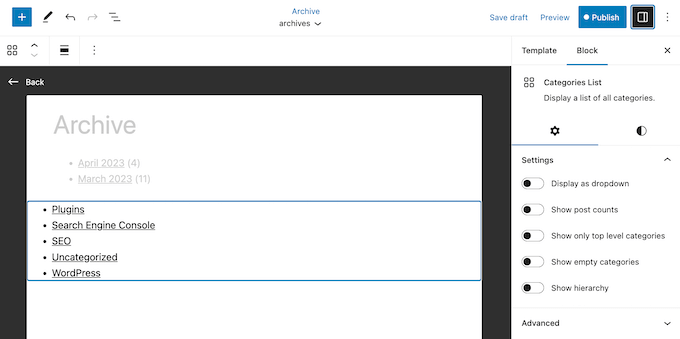
Potresti preferire mostrare le categorie figlie indentate sotto la loro principale.
Per apportare questa modifica, fai clic per attivare l'interruttore ‘Mostra gerarchia’.
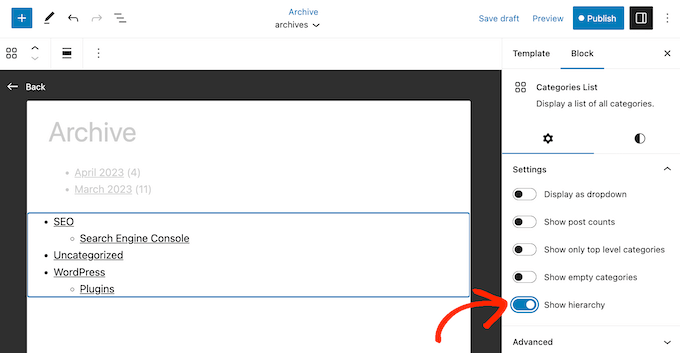
Un'altra opzione è nascondere completamente le categorie figlie attivando l'interruttore ‘Mostra solo categorie di primo livello’.
Potresti anche voler aggiungere una nuvola di tag, che può aiutare i visitatori a trovare contenuti correlati interessanti. Per farlo, trova semplicemente ‘Nuvola di tag’ nel menu di sinistra e trascinala sul tuo layout.
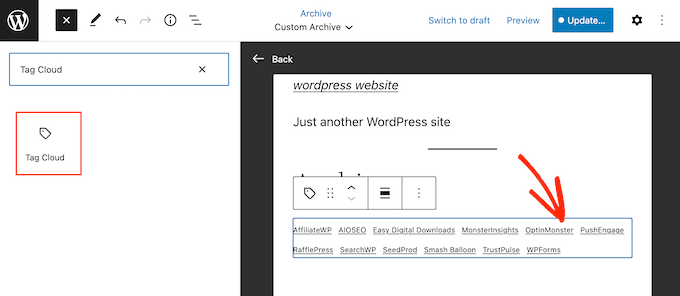
Ora puoi selezionare il blocco e configurarlo utilizzando le impostazioni nel menu di destra.
Per iniziare, la Nuvola di tag ha due stili: Predefinito e Contorno. Puoi passare dall'uno all'altro facendo clic sulla piccola icona del cerchio e quindi scegliendo una delle opzioni sotto ‘Stili’.
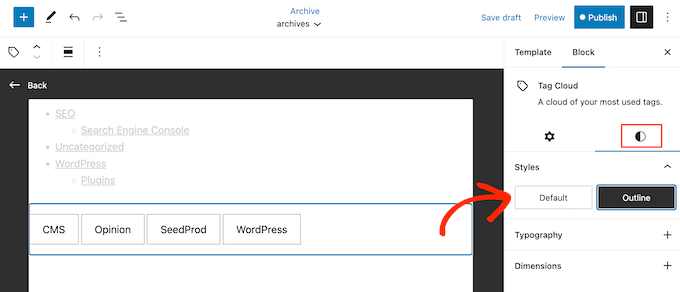
Puoi anche mostrare il numero totale di post accanto a ciascun tag e modificare il numero di tag inclusi nella nuvola.
Fai semplicemente clic sulla piccola icona a forma di ingranaggio e quindi apporta le tue modifiche in questa sezione.
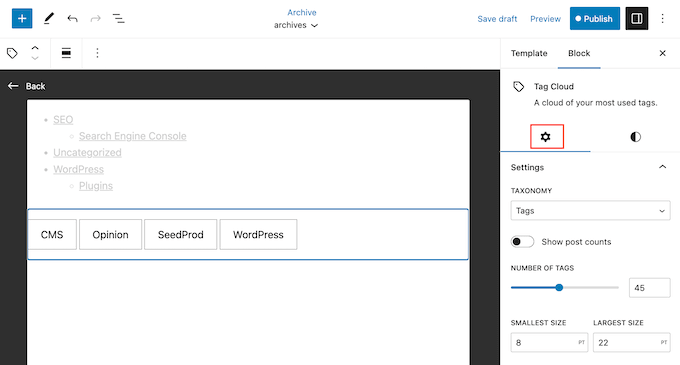
Nonostante il nome, puoi anche mostrare le categorie nella Nuvola di tag. Ad esempio, potresti preferire lo stile del blocco Nuvola di tag rispetto al blocco Categorie.
Per mostrare invece le categorie del tuo sito, apri semplicemente il menu a discesa ‘Tassonomia’ e quindi scegli ‘Categorie’.
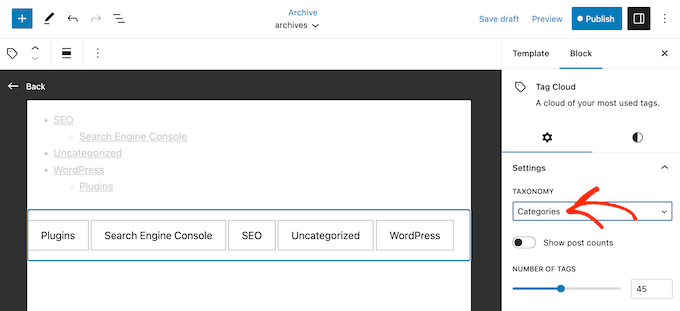
Gli archivi sono progettati per offrire ai visitatori un facile accesso a tutti i tuoi contenuti.
Tuttavia, potresti anche voler evidenziare i post più recenti del tuo sito aggiungendo un blocco Ultimi post.
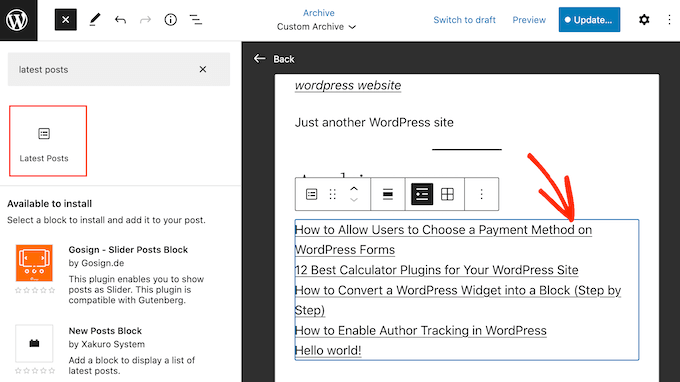
Per impostazione predefinita, questo blocco mostra semplicemente il titolo di ciascun post, ma puoi aggiungere l'autore, la data di pubblicazione e l'immagine in evidenza.
Utilizza semplicemente gli interruttori nel menu di destra per apportare queste modifiche.
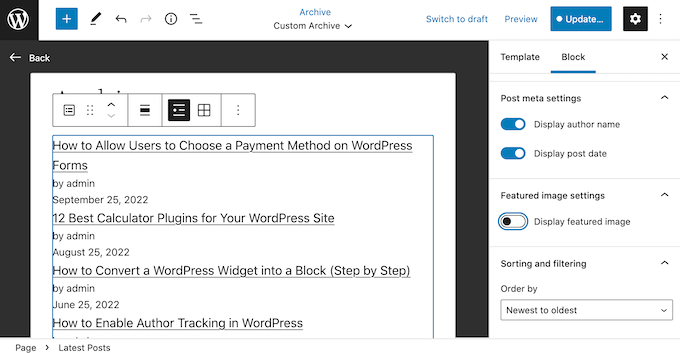
Potresti anche voler mostrare l'estratto del post, che può aiutare i visitatori a capire di cosa tratta ciascun post.
Per aggiungere gli estratti, fai clic per attivare l'interruttore ‘Contenuto del post’.
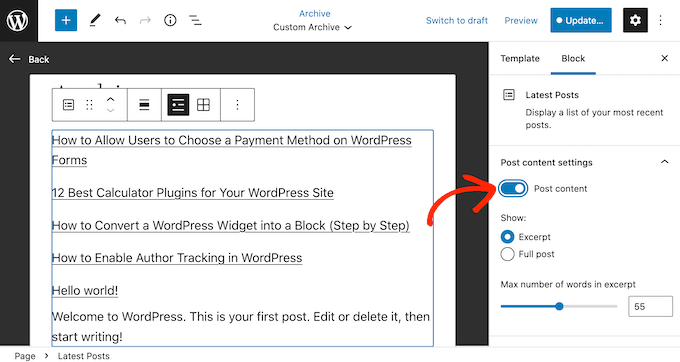
Successivamente, fai clic per selezionare il pulsante ‘Estratto’.
Per impostazione predefinita, WordPress mostrerà un massimo di 55 parole nell'estratto. Per mostrarne più o meno, utilizza semplicemente le impostazioni ‘Numero massimo di parole nell'estratto’.
Dopo averlo fatto, scorri fino alla sezione ‘Ordinamento e filtri’.
Qui, puoi vedere che il blocco organizza i post dal più recente al meno recente. Puoi cambiarlo aprendo il menu a discesa ‘Ordine’ e scegliendo un'opzione diversa, come ‘A-Z’.
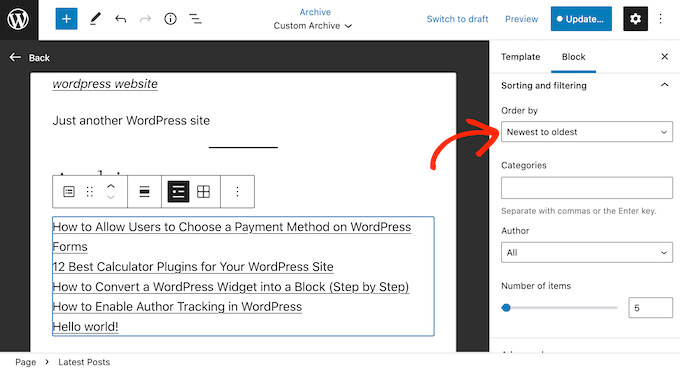
In questa sezione, puoi anche scegliere di mostrare post di un autore o di una categoria specifica.
Infine, puoi cambiare quanti post WordPress mostra nel blocco, digitando un nuovo numero nella sezione ‘Numero di elementi’ o trascinando il cursore.
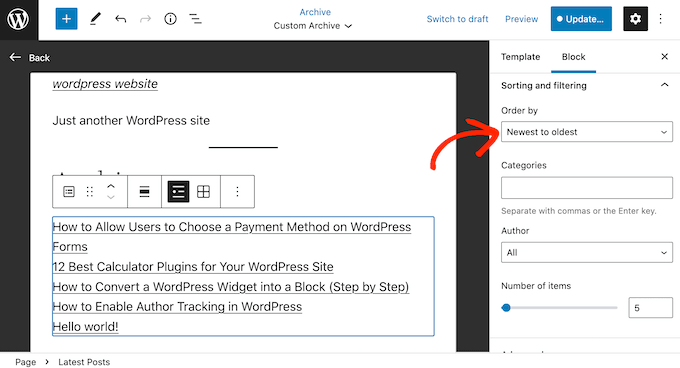
Puoi continuare a lavorare sulla tua pagina archivio aggiungendo altri blocchi e configurandoli nel menu a destra.
Ad esempio, potresti voler aggiungere un blocco Immagine e mostrare un logo personalizzato o aggiungere una barra di ricerca in modo che i visitatori possano cercare un post specifico.
Quando sei soddisfatto dell'aspetto del modello, fai clic sul pulsante ‘Pubblica’ e poi sul pulsante ‘Salva’.
La pagina creata in precedenza utilizzerà ora il nuovo modello di archivio. Puoi aggiornare o pubblicare la pagina, quindi visitare il tuo sito web WordPress per vedere la pagina di archivio personalizzata dal vivo.
Per ulteriori informazioni sull'utilizzo dell'editor completo del sito di WordPress, consulta le seguenti guide:
- Guida completa per principianti all'editor completo del sito di WordPress
- Guida per principianti: come utilizzare i pattern di blocchi di WordPress
Metodo 2: Crea una pagina di archivio WordPress personalizzata utilizzando Seedprod (Consigliato)
L'editor basato su blocchi ti consente di creare una semplice pagina di archivi personalizzata. Tuttavia, non funziona con tutti i temi e sei limitato ai blocchi e agli strumenti integrati di WordPress.
Se desideri creare una pagina di archivi completamente personalizzata che funzioni con qualsiasi tema WordPress, ti consigliamo di utilizzare invece un page builder.
SeedProd è il miglior page builder drag-and-drop per WordPress. Viene fornito con oltre 180 modelli e blocchi pronti all'uso, incluso un blocco che mostra tutti i post del tuo sito web.
Innanzitutto, devi installare e attivare SeedProd. Per maggiori dettagli, consulta la nostra guida passo passo su come installare un plugin WordPress.
Nota: Esiste una versione gratuita di SeedProd che ti consente di creare pagine personalizzate se hai un budget limitato e stai appena iniziando. Tuttavia, per questa guida, utilizzeremo SeedProd Pro poiché ha molti più modelli e blocchi.
Dopo aver attivato il plugin, SeedProd ti chiederà la tua chiave di licenza.

Puoi trovare queste informazioni nel tuo account sul sito web di SeedProd. Dopo aver inserito la chiave, fai clic sul pulsante 'Verifica chiave'.
Una volta fatto ciò, vai su SeedProd » Pagine di destinazione e fai clic sul pulsante 'Aggiungi nuova pagina di destinazione'.
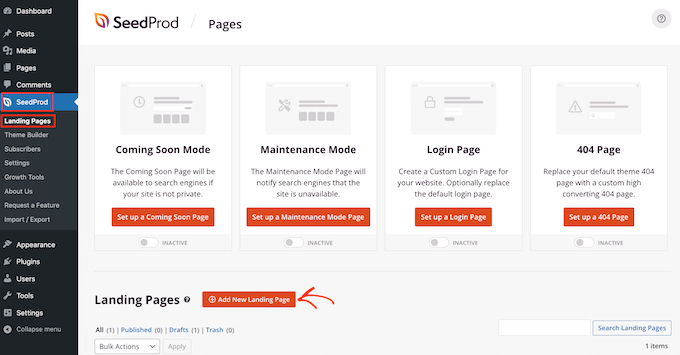
Ora puoi scegliere un modello per la pagina di archivi personalizzata.
I modelli di SeedProd sono organizzati in diversi tipi di campagne come lead squeeze, modalità di manutenzione, e coming soon. Puoi fare clic sulle schede nella parte superiore dello schermo per filtrare i design in base al tipo di campagna.
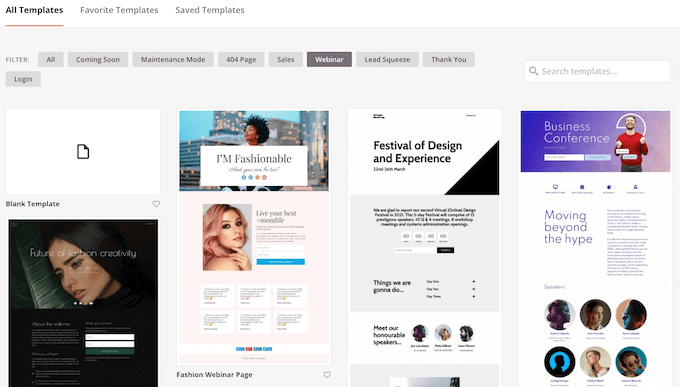
Per visualizzare in anteprima qualsiasi design, passa semplicemente il mouse sopra quel modello.
Quindi, fai clic sull'icona della lente d'ingrandimento che appare.
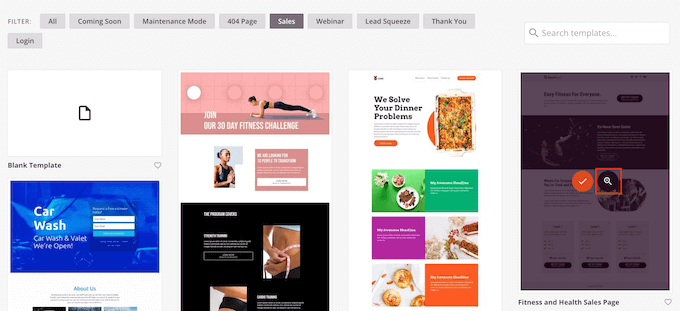
Quando trovi un design che ti piace, fai clic su ‘Scegli questo modello’. Stiamo usando il ‘Modello vuoto’ poiché ci consente di iniziare con una base pulita, ma puoi usare qualsiasi modello desideri.
Successivamente, digita un nome per la pagina personalizzata. SeedProd creerà automaticamente un URL basato sul titolo della pagina, ma puoi modificare questo URL se lo desideri.
Quando sei soddisfatto delle informazioni che hai inserito, fai clic sul pulsante ‘Salva e inizia a modificare la pagina’.
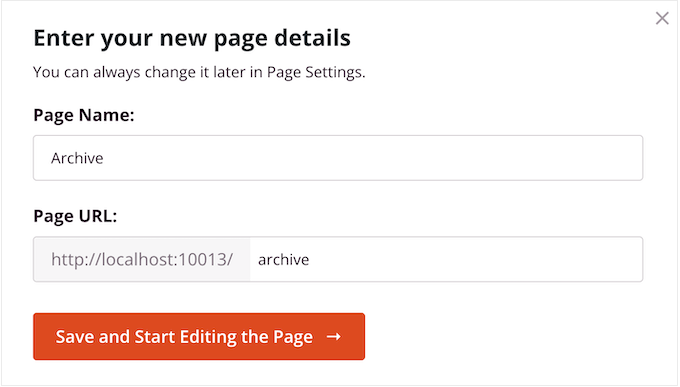
Questo caricherà l'interfaccia del page builder di SeedProd. È un semplice builder drag-and-drop che mostra un'anteprima live della tua pagina sulla destra.
Vedrai anche le impostazioni dei blocchi sulla sinistra.
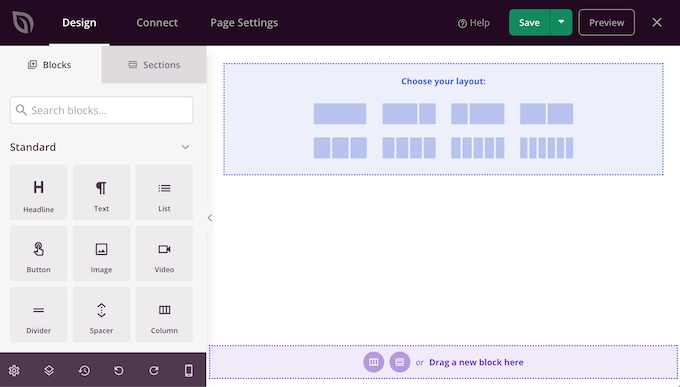
Per iniziare, dovrai scegliere un layout, che organizzerà il tuo contenuto in colonne.
Nella sezione ‘Scegli il tuo layout’, fai semplicemente clic sul layout che desideri utilizzare. Puoi scegliere qualsiasi layout, ma noi utilizzeremo il layout a schermo intero in tutte le nostre immagini.
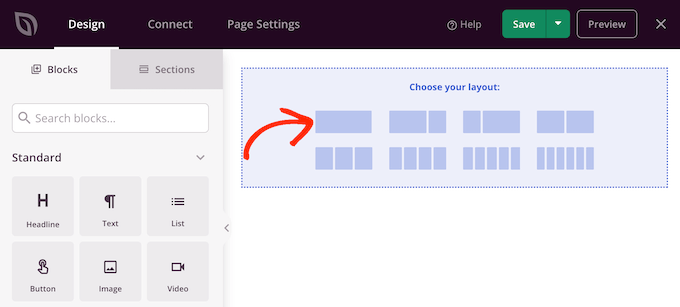
Dopo aver scelto un layout, puoi iniziare ad aggiungere blocchi alla pagina degli archivi.
Il menu di sinistra mostra tutti i diversi blocchi che puoi trascinare sul tuo progetto. Poiché stiamo creando una pagina di archivio personalizzata, aggiungeremo un blocco Post.
Nel menu di sinistra, inizia a digitare ‘Post’ nella barra di ricerca. Quando appare il blocco corretto, trascinalo e rilascialo sul tuo layout.
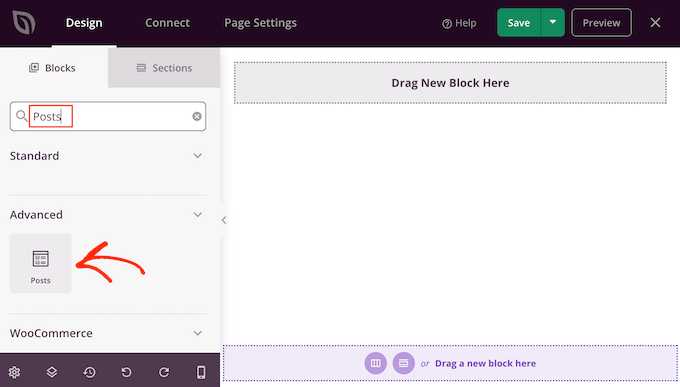
Questo blocco mostrerà ora il titolo di tutti i tuoi post.
Ha anche un link ‘Continua a leggere’ su cui i visitatori possono fare clic per leggere ogni post per intero.
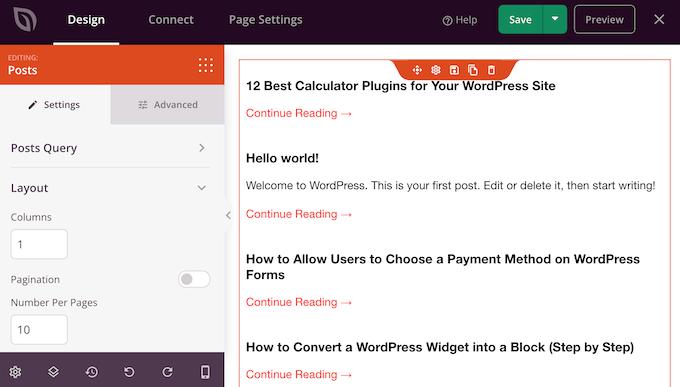
Per impostazione predefinita, questo blocco mostra tutti i tuoi post, ma puoi cambiarlo per mostrare solo i post che hanno una particolare categoria o tag, o post pubblicati da un autore specifico.
Per apportare questa modifica, fai semplicemente clic per selezionare il blocco ‘Post’ nel tuo layout e quindi utilizza le impostazioni nel menu di sinistra.
Ad esempio, nell'immagine seguente, stiamo mostrando solo i post della categoria ‘Marketing’.
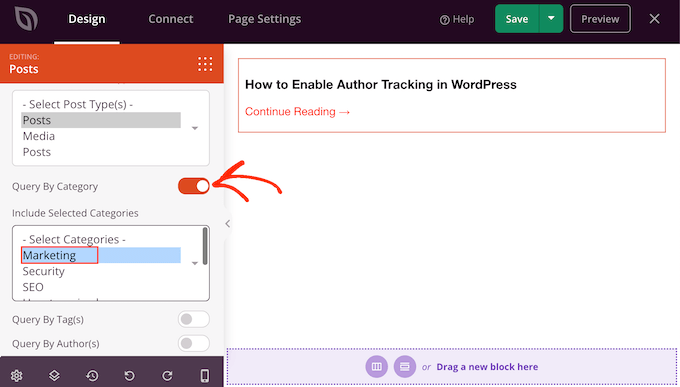
Puoi anche cambiare il modo in cui i post sono organizzati nel blocco. Ad esempio, potresti mostrare i post in base a quando sono stati pubblicati, o a quanti commenti hanno.
Per cambiare l'ordine dei tuoi post, scorri semplicemente fino alla casella ‘Ordina per’ e quindi scegli una nuova opzione. Per impostazione predefinita, SeedProd mostra i post in ordine ‘ASC’, che sta per ascendente.
Per disporre i tuoi post in ordine decrescente, apri semplicemente il menu a discesa ‘Ordine’ e scegli ‘DESC’.
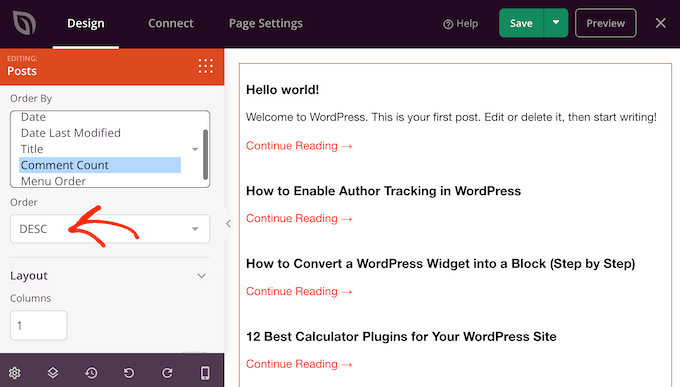
Dopodiché, puoi scorrere fino alla sezione ‘Layout’ e cambiare il modo in cui viene visualizzato l'elenco dei post.
Ad esempio, puoi dividere i post in più colonne digitando un nuovo numero nel campo ‘Colonne’.
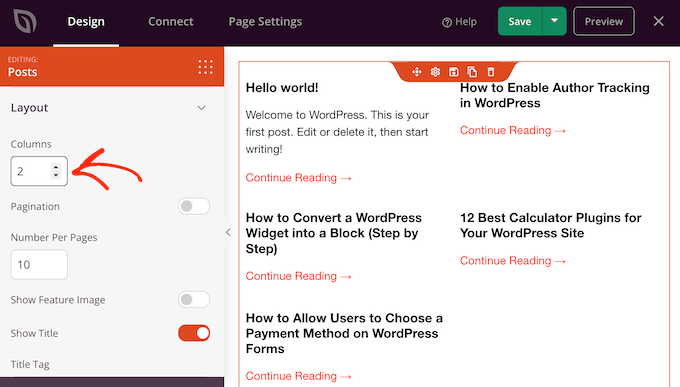
Puoi anche cambiare quanti post sono inclusi nell'elenco, aggiungere o nascondere gli estratti dei post e cambiare il testo ‘Continua a leggere’.
Quando sei soddisfatto dell'aspetto dell'elenco dei post, puoi aggiungere altri blocchi alla tua pagina archivio e quindi personalizzare tali blocchi utilizzando le impostazioni nel menu a sinistra.
Ad esempio, potresti voler incoraggiare le persone a seguirti sui social media aggiungendo un blocco 'Profili social'.
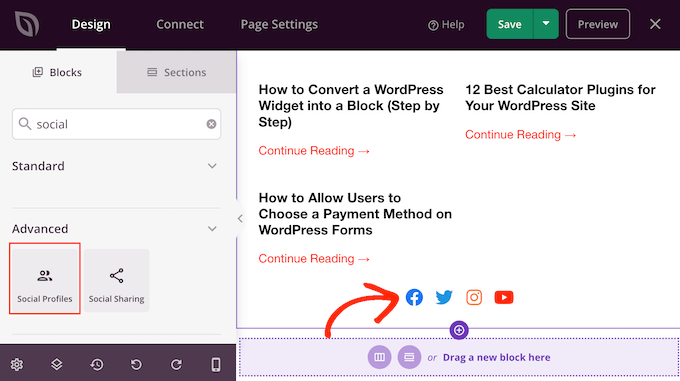
Quando sei soddisfatto di come è impostata la pagina, è ora di pubblicarla facendo clic sulla freccia a discesa accanto a 'Salva' e quindi selezionando 'Pubblica'.
La tua pagina personalizzata sarà ora attiva sul front-end del tuo blog WordPress.
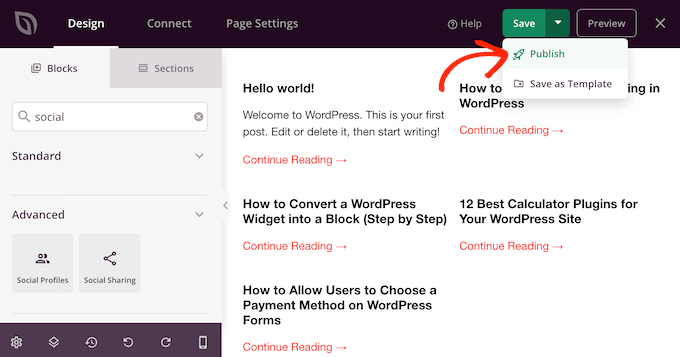
Per aiutare i visitatori a trovare la pagina archivio, potresti volerla aggiungere al tuo menu di navigazione o al piè di pagina del tuo sito web.
Scopri altri modi per organizzare i tuoi post di WordPress
Creare una pagina archivio personalizzata è solo un modo per organizzare i tuoi contenuti WordPress. Ecco alcuni metodi aggiuntivi per aiutare i tuoi lettori a scoprire e navigare i tuoi post in modo più efficace:
- Mostra i post più popolari – Evidenzia i tuoi contenuti più letti con plugin per i post più popolari. Dai un'occhiata al nostro confronto dei migliori plugin per i post più popolari per WordPress per trovare la soluzione giusta per il tuo sito.
- Visualizza i post per visualizzazioni – Scopri come visualizzare i post più popolari per visualizzazioni in WordPress utilizzando diversi metodi. Questo può aiutare ad attirare l'attenzione sui tuoi contenuti più coinvolgenti.
- Metti in evidenza i post nella barra laterale – Esplora diversi metodi per aggiungere post in evidenza nella barra laterale di WordPress. Questo è un ottimo modo per promuovere contenuti specifici o articoli recenti.
- Crea archivi di tipi di post personalizzati – Se utilizzi tipi di post personalizzati, puoi imparare come creare una pagina di archivio per tipi di post personalizzati in WordPress per organizzare questi contenuti specializzati.
- Mostra post correlati – Aumenta il coinvolgimento dei lettori mostrando contenuti correlati. La nostra guida passo passo su come mostrare post correlati in WordPress ti mostrerà come fare.
- Evidenzia i post più commentati – Mostra i tuoi contenuti più discussi con il nostro tutorial su come mostrare i post più commentati in WordPress utilizzando due metodi diversi.
- Riordina i post – Prendi il controllo dell'ordine dei tuoi post con la nostra guida su come riordinare facilmente i post in WordPress. Questo può essere particolarmente utile per creare elenchi curati o serie.
- Mostra post dello stesso autore – Incoraggia i lettori a esplorare altri contenuti di specifici scrittori con il nostro tutorial su come mostrare post correlati dello stesso autore in WordPress.
Speriamo che questo articolo ti abbia aiutato a creare una pagina archivi personalizzata in WordPress. Potresti anche voler leggere il nostro articolo sui migliori esempi di pagine "coming soon" e le nostre scelte di esperti del miglior plugin per post correlati in WordPress.
Se ti è piaciuto questo articolo, iscriviti al nostro canale YouTube per tutorial video su WordPress. Puoi anche trovarci su Twitter e Facebook.





Woolker Cherenfant
Grazie per questo utile tutorial. Ho seguito passo passo e ho la mia pagina archivio personalizzata attiva. Tuttavia, ottengo ancora l'archivio predefinito di WP sotto le mie impostazioni personalizzate. Potresti per favore dare un'occhiata e dirmi cosa ho fatto di sbagliato?
Grazie per la tua gentile risposta.
—Woolker Cherenfant
Woolker Cherenfant
Lascia perdere. L'ho risolto. Grazie.
—Woolker Cherenfant
Supporto WPBeginner
Ciao Woolker Cherenfant,
Purtroppo, è difficile per noi rilevare eventuali errori. Ti consigliamo di riprovare il tutorial e vedere se questo aiuta.
Amministratore
Neil
Mi chiedo se qualcuno possa aiutare?
Spero che qualcuno possa aiutarmi con un problema insolito che ho notato – e sembra che si verifichi da novembre 2017 o prima…
Ad esempio…
questo URL è stato generato/creato e non so come o perché… sembra che con due categorie se prendo un URL 'intero' e lo copio e incollo dopo la parte della categoria, solo l'URL allora si risolverà… (ed è stato indicizzato!)
cioè
Penso che questo sia successo solo con le pagine (archivio)…
A peggiorare le cose, questi URL sono stati indicizzati da Google. Non so se un plugin abbia causato questo o qualcos'altro…
Nota la singola '/' nella seconda parte dell'URL…
Supporto WPBeginner
Ciao Neil,
Si prega di consultare suggerimenti per la risoluzione dei problemi di WordPress per capire cosa ha causato questo problema.
Amministratore
Subhash
Egregio Signore,
Come personalizzare l'aspetto della pagina di archivio predefinita. Voglio aggiungere 2 barre laterali invece di 1 barra laterale. Sto parlando di questa pagina https://www.wpbeginner.com/2017/06/
Grazie
Supporto WPBeginner
Ciao Subhash,
Per questo dovrai modificare i file del modello date.php o archive.php del tuo tema e chiamare le tue barre laterali nel file del modello.
Amministratore
Subhash
Ciao Team di Supporto,
Grazie per la guida a riguardo.
Buona giornata!
Saluti
Subhash
Nyx
Tutorial meraviglioso! Grazie mille.
Domanda veloce, spero: ho usato le tue istruzioni per aggiungere "Aggiungere un elenco di tutte le categorie". Come posso far sì che il mio elenco sia giustificato all'interno dello spazio, invece che allineato a sinistra. Grazie per qualsiasi aiuto.
Dave Ward
Questo ha funzionato benissimo, ma vorrei visualizzare uno snippet effettivo delle pagine archiviate invece di un semplice elenco. C'è un modo per farlo?
Mohammad Kharoofa
Grazie per questo utile articolo, ho un problema. Aggiungi il codice al file style.css del mio tema. Dove dovrei incollarlo esattamente? perché ho provato a incollarlo ovunque ma non cambia nulla!
Emma
È possibile farlo con un account WordPress gratuito, o sono necessarie le opzioni di personalizzazione di uno dei piani a pagamento?
Thanks if you can let me know
Supporto WPBeginner
Ciao Emma,
Si prega di consultare la nostra guida sulla differenza tra WordPress.org self-hosted vs blog gratuito WordPress.com.
Amministratore
Andry
Ciao!
Sto preparando un sito di notizie con un tema WP ma ho una GRANDE domanda sugli archivi, forse potresti darmi la tua opinione grazie alla tua esperienza.
Il sito deve fornire una nuova versione ogni giorno (relativa all'edizione cartacea) e offrire una pagina di archivio che permetta di trovare le vecchie edizioni così come sono state pubblicate il giorno 'd'. I plugin in WP permettono solo di avere articoli per data, quindi abbiamo un elenco dei vecchi articoli per una data specifica ma non l'intera edizione (una copia completa del sito così come è stata pubblicata alla data 'd'). Conosci qualche plugin per WP per 'fare una copia' di un sito in modo che sia possibile collegare ogni 'data-copia' con una data nella tabella del calendario? o un plugin di archivio per avere automaticamente le vecchie edizioni? È possibile avere una cartella (nella directory WP) che contenga tutti gli articoli di un'edizione? così posso collegare ogni cartella a una data nella mia tabella del calendario?
– Hai nella tua lista dei preferiti un buon tema WP per giornali?
Grazie in anticipo!
Aaliya Thahseen
Carica il file page-archive.php nella cartella dei temi di WordPress, e avrai creato un modello di pagina Archivi.
Ho difficoltà con questa parte. Come carico il file page-archive.php nella cartella dei temi di WordPress?
Supporto WPBeginner
Puoi farlo usando un Client FTP. Il tuo provider di hosting WordPress ti fornirà i dettagli di accesso.
Una volta connesso al tuo sito tramite FTP, devi visitare la cartella /wp-content/themes/. Lì devi aprire la cartella del tuo tema e caricare il file dal tuo computer. Vedi la nostra guida su come usare FTP per caricare file su WordPress.
Amministratore
Cely
Ciao, ho seguito i passaggi per caricare il file php nella cartella del tema. poi sono tornato al mio wordpress, il template "archives" non c'è ancora. potresti aiutarmi per favore.
dwieyoko
come creare un modulo di ricerca e visualizzare i risultati della ricerca su archive.php.. ?
Kyran Wallace
Ciao
Ha funzionato benissimo per me! Grazie.
Una cosa però, il mio elenco di archivi non viene visualizzato sui dispositivi mobili. Attualmente sto utilizzando il plugin WPTouch per gli utenti mobili.
Potresti consigliare come risolvere questo problema per favore?
Grazie
Pete
Ciao, c'è un modo per elencare solo determinate categorie, cioè escluderne alcune dall'elenco?
Grazie.
Supporto WPBeginner
sì, puoi usare la funzione wp_list_categories in questo modo.
<ul> <?php wp_list_categories('exclude=4,7&title_li='); ?> </ul>1-click Use in WordPress
Sostituisci 4,7 con gli ID delle categorie che vuoi rimuovere.
Amministratore
loic
Salve,
Ho registrato diversi CPT.
Ho creato un template di pagina che elenca i post per un dato CPT.
Ho inserito una query (query_posts(‘posts_per_page=-1&post_type=my_cpt_one’); prima del loop.
Poi ho selezionato il template di pagina quando ho creato la pagina archivio del dato CPT.
Come usare lo stesso template di pagina per ogni CPT?
Ad esempio, voglio tre archivi di pagina chiamati "my cpt one", "my cpt two", "my cpt three" che richiamano lo stesso template di pagina.
Certo, potrei usare tre template di pagina, ma sto cercando un modo per usarne solo uno.
Il mio problema è impostare nella query lo slug del tipo di post.
È possibile?
Saluti.
Avdhesh Arya
Grazie mille! Questo mi ha aiutato molto nella creazione di una pagina Archivio personalizzata per il mio sito web.
Staff di WPBeginner
Ciò è perché il template tag wp_list_categories genera di default un elenco puntato delle tue categorie. Le sottocategorie vengono visualizzate con rientro sotto le loro categorie genitore. Puoi usare
<?php wp_list_categories('title_li=&style=none'); ?>per visualizzare le tue categorie con interruzioni di riga.Cara Zimmerman Seekell
Le mie categorie sembrano un po' sparse, hai idea del perché?
yasinatagun
Non possiamo farlo senza plugin? Voglio solo elencare tutti i miei post in una pagina. Non importa se ci sono 10000 post o 2 post. Voglio solo elencarli?
Luca
Vorrei creare un archivio annuale/mensile di una categoria specifica. È possibile usando con un filtro per una categoria specifica?
Aprile
Sto cercando ovunque la mia cartella dei temi… So un
pochino più del base per quanto riguarda la programmazione, ma lavorare con WordPress è stato
difficile per me nel cercare di trovare tutto. Forse non è compatibile con
quello che ho.
Sto cercando di creare una pagina sul mio blog per un elenco di post del blog archiviati che assomigli a questo: https://www.wpbeginner.com/archives/ con anno, mese e categorie. Ho molti post. Ho provato il plugin http://wordpress.org/plugins/archives/ per Archivi e ho creato una pagina e aggiunto [archives] e tutto quello che ho ottenuto è stata una lunga lista di tutti i titoli dei miei post del blog. Era lunga.
Ho trovato questo post https://www.wpbeginner.com/wp-tutorials/how-to-create-an-archives-page-in-wordpress/ ma non riesco a trovare una cartella themes in wordpress. Forse ho la configurazione sbagliata?
Sono ospitato con uno degli host esterni consigliati da Wordpress
utilizzando Wordpress per il mio blog. Il mio tema è Twenty Ten.
Se qualcuno potesse aiutarmi a ottenere il risultato che sto cercando,
mi aiuterebbe molto. Grazie!
Essekia Paul
Se qualcuno sta cercando una risposta a questo. Il percorso è:
Cartella principale di WordPress -> wp-content -> themes -> Twenty Ten
Membro presso Blc
Ho aggiunto la pagina archivio al mio sito ma voglio vedere solo la data / categorie e archivi nella sezione riservata ai membri. È possibile?
Membro presso Blc
Ho appena aggiunto la pagina archivio al mio sito ma voglio che le pagine dei post, le date e le categorie siano nascoste e visibili solo quando si accede. Le mie pagine dei post attualmente appaiono bloccate ma le vedo nella visualizzazione pubblica. Possono essere nascoste???
Avinash
Funziona perfettamente, quando ho provato ad aggiungere &show_count=1, il conteggio ha interrotto l'elenco delle categorie... puoi aiutarmi con il CSS necessario affinché il conteggio venga visualizzato correttamente.
Pawan Kesari
Molto utile. Ho appena aggiunto una pagina archivio al mio sito blog
Domanda: Questo file modello verrebbe eliminato durante l'aggiornamento del tema?
Supporto WPBeginner
Sì, lo farà, sarebbe meglio creare il file template in un child theme.
Amministratore
Charlie
Bella guida, ma c'è un modo per gestire qualcosa del genere in un plugin?
Nicole
Adoro questo tutorial! Tuttavia, voglio che la mia nuvola di tag sia separata da virgole. Ecco il codice che ho usato per la nuvola di tag (non voglio che le dimensioni dei font cambino, quindi ho mantenuto la più piccola e la più grande alla stessa dimensione)...
Tag
Qualche consiglio?
Supporto WPBeginner
Il tuo codice è stato rimosso dai commenti di WordPress. Questo snippet dovrebbe funzionare:
<?php $args = array( 'smallest' => 8, 'largest' => 22, 'separator' => ',' ); wp_tag_cloud($args); ?>1-click Use in WordPress
Amministratore
voltima
Grazie mille per un 'how-to' molto facile da capire.
Thomas
Ciao, grazie per l'ottimo tutorial!
Ho impostato l'elenco di tutte le categorie che sembra perfetto. L'unico problema che ho è che se aggiungo qualsiasi contenuto a quella pagina, l'elenco di tutte le categorie viene sempre posizionato in fondo. C'è un modo per impostarlo in cima alla pagina?
Archurst O. A
C'è un modo per mostrare per giorno o settimana invece dello stile archivio mensile?
sameera
Grazie. Ottimo lavoro.
Nad'
Ciao ragazzi,
Prima di tutto, grazie per questo fantastico sito web. Ho usato questo post per creare l'archivio ma da ieri la pagina dell'archivio non funziona più. Non ho cambiato il codice e ora l'unica cosa che vedo è Per data. dopodiché, non vedo più nulla, nemmeno la barra laterale o il piè di pagina.
Il mio template è in esecuzione localmente mentre lo sto costruendo. Avete qualche idea su cosa possa aver causato questo?
grazie
Supporto WPBeginner
sembra un errore di codifica nel tuo template che sta rompendo il template subito dopo aver visualizzato i tuoi archivi per data.
Amministratore
meki
Ho copiato il codice che hai fornito ma il mio sito non mostra alcun tipo di archivio. Il tuo codice ha un errore. Alla riga n. 16 stai chiudendo ?>php poi iniziando html, che semplicemente stamperà html sulla pagina. Ho attivato il plugin, corretto il codice ma la mia pagina è ancora vuota. Lasciami correggere, grazie.
Meki
Nemmeno io ho una page.php.
Meki
qualche risposta?
Supporto WPBeginner
Meki, ci dispiace ma non riusciamo a capire il problema che stai riscontrando. Per quanto riguarda il file page.php, potresti star usando un Theme Framework, quindi il tuo tema potrebbe non mostrare un file page.php. Ti preghiamo di contattare l'autore del tuo tema e chiedere quale file dovresti usare come base per i tuoi template di pagina personalizzati.
Craig Parker
Fantastico. Devo metterlo nei preferiti e tornare, ma una pagina di archivi è qualcosa a cui stavo pensando da un po'.
Kelly
Ottimo tutorial. Potresti chiarire qualcosa prima di iniziare. Sto usando un tema figlio. Devo aggiungere il file page-archive.php nella cartella dei "file del tema" effettivi o devo metterlo nella cartella del tema figlio? Allo stesso modo... Ora dobbiamo stilizzare questo elenco, farlo apparire in linea e migliorarne l'aspetto. Aggiungi questo al file style.css del tuo tema. Suppongo di poterlo aggiungere all'interno del mio tema figlio come CSS personalizzato; è l'approccio corretto?
Supporto WPBeginner
Sì, questo è l'approccio corretto.
Amministratore
gary bvings
Vorrei combinare le due idee di visualizzazione dell'archivio sopra. Ho due categorie: Auto e Barche. Vorrei mostrare gli archivi mensili (con il plug-in Compact Archive) per ciascuna. Quale php devo usare? Grazie.
Maschil
Great tutorial — thanks It has worked perfect!
It has worked perfect!
Ho copiato e incollato il CSS fornito nel mio file CSS e non ha cambiato affatto l'aspetto. Pensieri?
Supporto WPBeginner
Dipende da dove hai copiato e incollato il tuo CSS.
Amministratore
Kate Reid
Grazie mille per questo post davvero utile. Ho appena iniziato a usare un tema molto minimale, quindi questa pagina di archivio personalizzata è perfetta per aiutare la navigazione. Ha un bell'aspetto!
nicole holgate
Ciao,
Ottimo plugin e facile da usare.
Sto cercando di usarlo per una pagina di archivio di post personalizzati (solo i post personalizzati da elencare per anno, per mese.
Funziona con i tipi di post personalizzati?
With thanks
Nicole
Emily
Ok, penso di aver capito dove caricarlo, ma ora non supporta il mio file di blocco note.
Supporto WPBeginner
Assicurati che il nome del tuo file sia page-archive.php e non page-archive.php.txt o page-archive.txt
Amministratore
Emily
Non capisco dove caricare il mio file page-archive.php. Dov'è la cartella del tema di WordPress?
Sheeba Yousuf
Ho creato Archives.php e quando sulla pagina clicco sugli archivi non ottengo quale template stanno usando i post (post personalizzati), è un casino in realtà. Potresti per favore aiutarmi.
Chris Raymond
Vedo che stai usando the_content nel loop, ma quando clicchi su un mese e vedi i post, mostra solo uno snippet. È controllato da un'altra funzione personalizzata? Potrei invece usare the_excerpt?
TIA, post molto utile
Supporto WPBeginner
the_excerpt mostrerà un breve estratto dei post. the_content viene utilizzato per visualizzare post completi. Vedi questa guida Full Post vs Summary (Excerpt) in WordPress Archive pages.
Amministratore
real name
buon lavoro amico… continua così
Atanas
Beh… questo post è piuttosto utile ma ho un problema… Ho il tema Thesis 1.8 e non riesco a trovare il file page.php nella cartella del mio tema… Triste… Qualche idea…
Supporto WPBeginner
Thesis è un framework per temi, devi controllare la Documentazione di Thesis per imparare come apportare queste modifiche.
Amministratore
Saranya
Ottimo tutorial. Mi ha aiutato molto come principiante. Grazie mille.
Syed Irfan
Syed, stai facendo un ottimo lavoro per i principianti, e penso che sia un grande servizio specialmente per i meno esperti proprio come me. Masha Allah e JazakAllah!
Carol
C'è un modo per limitare l'output degli archivi compatti a una categoria di post invece che a tutti i post?
Kenny
L'ho trovato troppo difficile da aggiungere a un tema Woo. Il file page.php del framework Woo è troppo complesso per capire dove inserire il codice aggiuntivo per gli archivi compatti. Non ha uno spazio commentato come quello di esempio.
Nusa Herba
Stiamo cercando di creare qualcosa di simile, grazie per il tutorial, molto utile.
Kenny
Così tempestivo! Nell'ultimo quindicennio sono stato frustrato dalla difficoltà di visualizzare i post d'archivio in sequenza temporale e in altri modi. E mi chiedevo se i miei lettori avessero lo stesso problema. Non mi piace aggiungere codice, ma farò un'eccezione in questo caso. Grazie.
Amy
Bel tutorial!